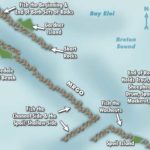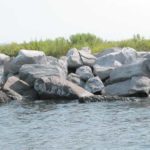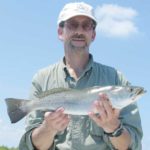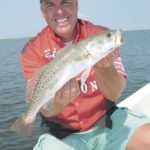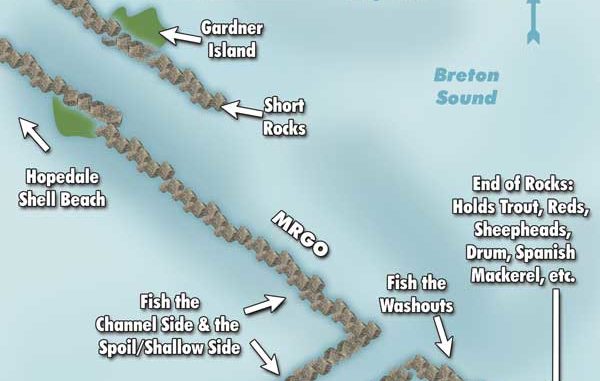
The nation’s longest jetty has been on fire this summer. Here’s everything you need to know to get in on the action.
I’m going to let you in on what may be the poorest-kept secret of the summer: The rocks at the end of the MRGO are on fire, and they have been for the whole summer.
Speckled trout are plentiful all along both sides of the jetties, and redfish, sheepshead and big croakers aren’t in short supply either. I have to admit a certain reluctance in even writing this, because the area is where I’ve been fishing, and there’s already plenty of company out there.Almost every trip I’ve made this summer has been to the rocks, unless I was fishing in someone else’s boat. Sometimes I also venture out to the rigs in Bay Eloi or if I want bigger fish I’ll head to the more-distant rigs in Breton Sound, but I usually wind up, either on my way out or the way in, at the rocks.
I’ve fished these rocks for decades, and I’ve found that the fishing action does run in cycles — good in some years, not so good in others, but generally pretty consistent overall. I’ve also noticed that the longer the rocks sit undisturbed, the better they produce.
Over time, they have a tendency to settle down and sink beneath the surface. The reason for that is obvious. The rocks weigh tons, and the bottom is soft. The submerged rocks were still productive, but in the past the Corps of Engineers would invariably barge in thousands of tons of more rocks to stack on top of the others and build the jetties back up again. And every time they did that, the fishing action slowed dramatically for a season or two or three.
I remember some years the rocks were red hot and you could almost guarantee a limit there every trip. And I remember some years when you couldn’t buy a fish at the rocks. Fortunately, we’re in the hot cycle right now, and there’s action aplenty along the strewn boulders.
Like I said, I’ve been fishing them all summer in a variety of ways. Generally our technique is pretty basic — we anchor within casting distance, and cast live shrimp under popping corks. We give the spot a short time to produce, and if we get no action, we pull up anchor and repeat the process somewhere else along the rocks.
There’s no shortage of places to try. The long rocks stretch out for eight miles, making it the longest jetty in the country. The short rocks must stretch for at least three miles, for a combined total of 11 miles, and if you consider that you can fish both sides of each jetty, that’s 22 miles of rocks to choose from and plenty of room for everybody.
If I get no action after I move a few times, I’m ready to drop the trolling motor and troll the rocks, which is one of my favorite techniques.
My fishing partner, Sal Scurria, however, is of the sit-and-wait persuasion. He is convinced that the fish, both reds and specks, are in continual motion along the rocks. His theory is that you simply pick a spot, anchor and stay there. Soak live bait under a popping cork and keep that shrimp smell in the water, and sooner or later the fish will come to you. The irritating thing about that theory is that it sometimes produces results, which only further convinces Sal that he’s right.
Case in point: Sal recently took his son, Sal III, and Hilton Petit on a rock excursion. They anchored the boat and tossed baits toward the rocks, and didn’t move. And they caught their limits. Not all in one swoop, but in spurts. They’d catch five or six at a time, and then a dead period, and then three or four, followed by another dead period.
But by staying with the game plan and sticking it out in that one spot, they wound up with their three-man limits.
Scurria offered as further proof of his theory the fact that every time they had a flurry of activity and started catching fish, the fish were all of the same size. They’d have a flurry of 13-inch fish, followed 15 minutes later by a flurry of 15-inch fish, which, he declares, is proof positive that schools of trout patrol up and down the rocks, because trout tend to run in schools of same-sized fish. Park and wait, he theorizes, and the fish will come to you.
I exploded his theory the next day when I parked at the same spot and waited for over an hour and caught only three small fish. Yes, I know that conditions change in a day. Moon phases, tides, barometric pressure, wind direction and water clarity can all dramatically change in a single day, and just because you loaded the boat in a certain spot yesterday is no guarantee you’ll repeat that today.
But I chose to ignore all that to make my point that parking and waiting for fish to swim to you is a lazy man’s technique, and if you give a spot some time to produce and it doesn’t, pull up that anchor and move elsewhere. Better yet, drop that trolling motor over, and put it to some use other than a hood ornament.
Which is exactly what I did. I trolled very slowly along the rocks, and while my buddies tossed live baits under popping corks, I tossed soft plastics on ¼-ounce jigs right up along the rocks, and tried to bounce them back to the boat without snagging on the bottom. If you toss plastics up to the rocks, snags are inevitable, and I had to do a lot of retying, but I caught some very nice trout in the process. In fact, almost all the bigger fish were caught with plastic.
The bottom line is, judging by my own personal experience, both techniques work. You can park and wait, or you can troll until you find them. In fact, you can do both. Anchor and fish live shrimp under popping corks. Give it some time and if you get no action, move and either anchor elsewhere and try again, or troll. Either way, you should catch some fish.
Right after my last fishing trip to the rocks, I got a call from Capt. Barry Brechtel from over at the Breton Sound Marina. I had called and left him a message because I was hoping to hitch a ride on his boat into Breton Sound to do an August article at some of the rigs. I had Central in mind, or perhaps the area many refer to as Little Central. Brechtel called with an even better idea.
“Let’s go fish the rocks at the end of the MRGO,” he said.
Maybe my response sounded a little unenthusiastic.
“Listen to this idea,” he explained. “The rocks are red hot right now, and they are easily accessible by smaller boats. To fish the sound, you really need a big boat, but almost anybody with an outboard motor on a flatboat can fish the rocks. It’s a straight shot down the Ship Channel, so you can’t get lost, you are protected on just about everything but a southeast wind, and you won’t burn much fuel. The rocks are win-win right now.”
I guess he still noticed some hesitation in my voice. Not that I didn’t agree with him, because I did. I was simply wrestling with an internal debate about inviting the whole state to come fish in my fishing hole. The struggle went something like this: “Those are my rocks. I don’t want everybody in Louisiana fishing at my rocks. This is my secret! If we do an article, everybody will know! The secret will get out!”
Then the voice of reason would inject: “It’s everybody’s rocks. And there are no secrets! And there are 22 miles of rocks to fish along, plenty enough for everybody.”
So reason won out, and I arranged to meet Brechtel at the dock of the Breton Sound Marina long before daylight. He met me with the 250-horsepower Yamaha outboard already purring on a brand-new 22-foot Twin Vee Bay Cat, and except for a short trip to tow in a stranded boater, ours would be the inaugural run and the first trip to actually slime up the floor. I love christening a new boat with speck slime!
The baitwell was already loaded with live shrimp, and Brian Graves, our fishing partner for the day, and I stowed our rods and gear aboard, and Brechtel pointed the double bow toward the sound.
Thirteen miles later, we made the first of what would be several stops along both the long and short rocks, and not surprisingly, we caught fish at almost every stop. I said almost, because at one stop, the one we both thought would be the most productive, we didn’t get as much as a nibble. That was at the very end of the long rocks, normally a pretty consistent spot to anchor and toss live shrimp either along the rocks or into the moving water or current just behind them. You almost always find schools of mullet and baitfish right there, and specks, reds, Spanish mackerel, drum, sheepshead, banana fish and the occasional shark among them. But that was the only spot that didn’t produce that day.
On our first stop, we put about 25 specks into the boat, and could have probably stayed right there and caught our three-man limits. But we wanted to move around and fish several different places, and see if we could find larger fish. Brechtel says you can fish virtually anywhere along the rocks, but he has a few favorite spots and some definitely helpful tips.
“The key to catching fish consistently out here is to, first of all, fish with the wind,” he said. “You want the wind at your back, pushing the water and the bait into the rocks. Tide really doesn’t matter, whether it’s rising or falling, as long as you have some movement. Either way, you can usually find some pretty clear water along the rocks.”
Brechtel says the second key is to fish the channel side under a cork about 5 to 6 feet deep.
“You don’t have to toss your cork right up into the rocks to catch fish,” he said. “You can catch fish there, but you’ll lose a whole lot of tackle. Just notice how many corks you see bobbing along the rocks, still snagged.
“Instead, toss anywhere from 6 to 10 feet off the rocks, up to 20 feet off, under a sliding cork or a popping cork set about 5 to 6 feet deep. I seldom fish any shallower than that at the rocks, unless I’m on the back side. On the back side, you can fish 2 to 3 feet under a cork.”
Brechtel’s next tip is to fish both ends of both sets of rocks.
“Fish the beginning and the end of both the long rocks and the short rocks,” he said. “Fish them the same way. Anchor, toss live shrimp 5 or 6 feet under a popping cork and give each spot some time to produce. The fish will find you.”
His fourth tip: “Fish the breaks in the long rocks, where the current washes through. I always found those spots to be productive.”
We stopped at one break, made a dozen casts and caught several nice trout before moving on to another where we caught a dozen more.
Tip five: “Fish the spoil island on the back side of the long rocks.
“The island is about a mile or two from the end of the long rocks, and the key here is to anchor or troll, and cast out toward the open water, rather than toward the bank. The water isn’t too deep, so you’ll want to fish 2 or 3 feet deep under a popping cork, and you need a moving tide. If the tide is slack, forget that spot. But if you have some decent tidal movement, give it a try.”
Brechtel’s next tip: “Fish the Cut, inside the Cut itself, with a sliding cork on the bottom, using live or dead shrimp, for reds, drum and sheepshead.”
The Cut is a channel about halfway down the long rocks, leading away from the Bay Eloi side over toward the Delacroix side. Brechtel says there is usually a lot of current pushing through the Cut, making it an unlikely place to catch specks except on days with little tide. But it is an excellent spot to catch reds, and anglers can also fish the shallow sides of the Cut under a popping cork for specks and scattered reds.
As for best and worst conditions, Brechtel says the worst-case scenario is to have strong winds blowing in from either the southeast or from the northwest, either of which blows straight down the MRGO and makes for difficult conditions.
Other than that, you’d have to have rocks in your head not to give these rocks a try!
Capt. Barry Brechtel can be reached at (504) 610-6914.
